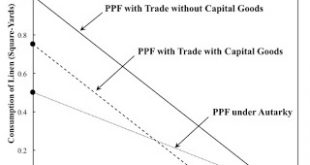1.0 Introduction I have not posted about a non-fluke switch point in a while. This is an example from Bertram Schefold. I have examined perturbations and variations of this example before. Here I present an example with tables exhibiting arithmetic. Is this any more transparent than examples presented with graphs? I have been listening to some lectures on YouTube, especially Richard Wolff. I now have another hypothesis why mainstream economists have been promoting lies, ignorance, and...
Read More »Structural Economic Dynamics And Reswitching In A One-Good Model
This post, as suggested, extends this one-good example. I assume a constant returns-to-scale technology, as specified in Tables 1 and 2. Labor is advanced to the capitalists, and wages are paid out of the surplus at the end of the year (period of production). The capitalists (incorrectly) expect the technology in existence at the start of the year to continue to exist. I assume prices of (re)production prevail. Table 1: Inputs for The Technology InputProcess(I)(II)(III)Labor30 eσ0,1(1 -...
Read More »Lewin and Cachanosky on Neo-Ricardian Economics [Citation Needed]
This post is about the misrepresentation of Sraffian capital theory in Lewin and Cachanosky (2019). I cannot recommend this short book. Presumably, it is meant as an introduction. But I do not see it as succeeding. I do not see what a more advanced audience would get out of it that is not available in a few recent papers by Lewin and Cachanosky. Before proceeding to my main theme, let me note that I agree with some parts of this book, mainly where Lewin and Cachanosky draw on Ludwig...
Read More »On Hicks’ Average Period of Production
Figure 1: APP Around Switch Points1.0 Introduction I take it that the Austrian theory of the business cycle builds on Austrian capital theory. The following two claims are central to Austrian capital theory: Given technology, profit maximizing firms adopt a more capital-intensive, more roundabout technique at a lower interest rate. The adoption of a more roundabout technique increases output per worker. Originally, Eugen von Böhm-Bawerk proposed a physical measure of the average period...
Read More »Refutation Of Austrian Business Cycle Theory
Those who understand price theory reject the theory of the Austrian Business Cycle (ABC). I am thinking here that its logical invalidity follows from post-Sraffian capital theory. It is also wrong because of its reliance on the concept of the natural rate of interest. Some years ago, I tried to get published a demonstration that ABC theory was in error. I forget how many journals rejected it. Four or five articles here are from this series of revisions. The rejections from the journals...
Read More »Some Reviews of Quiggin’s Economics in Two Lessons
I have been thinking of posting a review of Quiggin's book, but this is not it. I suppose I should mention that I am in the acknowledgements. Jorge Besada raves at the Mises Institute. Peter Boettke on his blog. Tyler Cowen lists Quiggin's book in his current reading. Diane Coyle on her blog. David Gordon at the Mises Institute. Richard Holden at Inside Story. Arnold Kling on his blog. "hayekian" raves. Quiggin has a response to a couple of the above. By the way, he had a paper, in 1987,...
Read More »Arguing Against “Libertarianism”
1.0 Introduction By "libertarianism", I mean propertarianism, a right-wing doctrine. In this post, I want to outline some ways of arguing against this set of ideas. (On this topic, Mike Huben has much more extensive resources than I can allude to.) 2.0 On Individual Details I like to use certain policy ideas as a springboard for arguments that they have no coherent justification in economic theory. Unsurprisingly, the outdated nonsense market fundamentalists push does not have empirical...
Read More »A Unique Natural Rate Of Interest?
1.0 Introduction In explaining the policy implications of the Austrian Business Cycle Theory, Hayek argued that the central bank should try to keep the money rate of interest rate equal to the natural rate. Sraffa famously criticized Hayek by describing a model with multiple interest rates, not necessarily all equal. In reply, Hayek asserted that all the interest rates in Sraffa's example would be equilibrium rates. Sraffa had a rejoinder: "The only meaning (if it be a meaning) I can...
Read More »A Country Worse Off With Trade In Capital Goods
Figure 1: PPFs in Portugal1.0 Introduction This post continues these two posts. I change the model here to have wages advanced, not paid out of the surplus at the end of the year. I here consider an example of a model of stationary states in which two countries can trade in produced commodities to be used for consumption. The countries face given prices on international markets for traded commodities. (They are small open economies, in the jargon.) I take the rate of profits as given in...
Read More »More On Foreign Trade In Consumer And Capital Goods
Figure 1: Rates Of Profits for Specialization in Consumer Goods1.0 Introduction This post is a continuation of this example. How a country specializes in foreign trade depends on distribution. And foreign trade can reduce the consumption basket to be divided among the inhabitants of a country, as compared with autarky. 2.0 Patterns of Specialization Assume that the consumption basket in both countries contains both corn and linen. In a steady state, international prices and the...
Read More » Heterodox
Heterodox




